Irish Naval Service
| Naval Service | |
|---|---|
| An tSeirbhís Chabhlaigh (Irish) | |
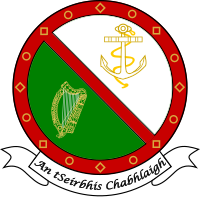 Emblem of the Naval Service | |
| Founded | 1 September 1946[1] |
| Country | |
| Type | Navy |
| Role | Defence of the state and protection of its maritime resources |
| Size | 1,094 personnel 115 active reservists (Establishment: 300)[2] 9 ships (5 operational)[3] |
| Part of | |
| Naval base | Haulbowline, County Cork, Ireland |
| Colours | 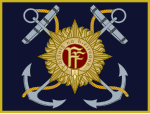 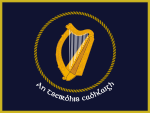 |
| Website | www |
| Commanders | |
| FOCNS | Commodore Mick Malone[4] |
| Supreme commander | President Michael D. Higgins |
| Insignia | |
| Naval ensign |  |
| Naval jack |  |
The Naval Service (Irish: an tSeirbhís Chabhlaigh) is the maritime component of the Defence Forces of Ireland and is one of the three branches of the Irish Defence Forces.[5] Its base is in Haulbowline, County Cork.
Though preceded by earlier maritime defence organisations, the Naval Service was formed in 1946.[6] Since the 1970s a major role of the Naval Service has been the provision of fisheries protection in Ireland's exclusive economic zone (EEZ).[7][8][9][10][11][12][13] Other roles include sea patrol, surveillance, and smuggling prevention.[14] Occasionally the service undertakes longer missions in support of other elements of the Defence Forces, Irish peacekeepers serving with the United Nations, or humanitarian and trade missions.[14]
From July 2017 the Naval Service has participated in the European External Action Service mission which focuses a number of EU navies on humanitarian and training roles in the Mediterranean. This mission entitled "EU Navfor Med" is the first time Ireland has taken part in a multi-role and multi-national naval operation.
Ships in the Irish Naval Service are designated Long Éireannach, which is abbreviated to LÉ. LÉ Eithne is the current flagship of the Naval Service.
History[]

Coastal and Marine Service[]
The Anglo-Irish Treaty of 1921 stipulated that the Irish Free State was to be given the responsibility to police its customs and fishing, while the United Kingdom would remain in control of Irish waters. In 1923 the Coastal and Marine Service (CMS) was created, and one year later it was disbanded.
During the Irish Civil War, in August 1922, a ship belonging to the British & Irish Steam Packet Company, Lady Wicklow, led by Captain Patrick Ryan, was used to bring Irish National Army troops around the coast to Fenit, the port of Tralee, in County Kerry.[15] This naval involvement technically preceded the foundation of the Irish state, as Ireland was still part of the UK at the time.[16] Built-in 1890 in Dublin Dockyard, the ship measured 262 by 34 feet (80 by 10 m). In all, 450 troops, including officers, were landed. Tralee was later captured from local republican forces.
Muirchú, formerly the British armed steam yacht Helga,[17] which had been used by the Royal Navy to shell Dublin during the 1916 rising, was the only CMS ship during this period. The CMS ship Muirchu continued to patrol Irish fisheries. Muirchu was re-armed in 1936 and purchased by the Irish government on advice of members of the later named Maritime Institute of Ireland for fisheries protection.
In 1938 the United Kingdom handed over the three treaty ports (Cork Harbour, Bere Haven and Lough Swilly). Consequently, the Royal Navy withdrew from Cork Harbour in July 1938. Fort Rannoch was added to the Irish fleet at that time.
Marine and Coastwatching Service[]
In 1939 the Irish Government ordered two motor torpedo boats (MTBs) from Vosper Thorneycroft.[18] When World War II began in September 1939 the Marine and Coastwatching Service was set up. In order for Ireland to remain neutral, it became clear that a full naval service would be required. The government consequentially ordered an additional four MTBs.[19][20] By the end of 1940 the Irish Marine and Coastwatching Service consisted of six MTBs and four other assorted craft.
During the war the service protected fisheries, regulated merchant ships, and laid mines off Cork and Waterford.

In June 1940, an Irish Marine and Coastwatching Service MTB returned to Haulbowline after making two trips to rescue British and French soldiers during the Dunkirk evacuation.[21]
By 1941 the Marine and Coastwatching Service consisted of 10 craft (6 MTBs plus 4 assorted vessels) and about 300 all ranks. In 1942 the service was renamed the Marine Service.
[]
In September 1946, the Marine Service was formally disbanded and the Naval Service established as a permanent component of the Irish Defence Forces. The Naval Service purchased three Flower-class corvettes from the United Kingdom in 1946 and 1947. The tradition of naming Irish Naval Ships after figures in Celtic mythology began, and the ships were named Cliona, Maev and Macha. These three ships were to become a key part of the Naval Service in the 1950s and 1960s. The first formal training of Irish naval cadets took place at the Britannia Royal Naval College, Dartmouth, UK, in 1947.[22] In 1970, Cliona and Macha were withdrawn from service and scrapped, leaving Maev as the sole ship in the Naval Service. Maev was withdrawn from service in 1972.[23] In 1971, the Naval Service commissioned three armed Ton-class minesweepers: Grainne, Banba and Fola.

In 1971 the Naval Service commissioned Verolme Cork Dockyard to build an offshore patrol ship. Named LÉ Deirdre, it was the first naval vessel purpose-built in Ireland to patrol its waters. The exclusive economic zone of Ireland was increased in 1976 from 12 miles (19 km) to 200 miles (320 km). The subsequent strain put on the Naval Service prompted funding from the European Economic Community to acquire five additional vessels, four of which were eventually built. Meanwhile, the former Irish lights vessel Isolda was purchased to act as a training ship, bearing the pennant number A15 and renamed LÉ Setanta (A15). It served until being sold for scrap in 1984. A Danish stern trawler Helen Basse was also leased for a year, serving under the name LÉ Ferdia, pennant number A16.[24]
The 50th anniversary of the Naval Service took place in 1996. Celebrations included a fleet review by President Mary Robinson. In 1999, a new ship LÉ Róisin was delivered to the Naval Service, marking the beginning of a new class of larger patrol vessels followed by LÉ Niamh, commissioned in September 2001 replacing LÉ Deirdre.

While most missions undertaken by the Naval Service are in Irish waters, on occasion longer missions are undertaken in support of Irish peacekeepers serving with the United Nations, representing Ireland, or in support of Irish trade missions. In 2002, LÉ Niamh delivered supplies to Irish troops in Eritrea, then continued on a trade promotional tour to India, Malaysia, Singapore, Hong Kong, China, Korea, and Japan, becoming the first Irish naval vessel to cross the Equator. In 2006 LÉ Eithne travelled to Argentina, attending ceremonies connected with the 149th anniversary of the death of Irish-born Admiral William Brown, founder of the Argentine Navy, and also visited ports in Uruguay and Brazil. In 2010, Niamh travelled to the Americas, visiting Brazil, Argentina, Chile, Mexico and the United States.
In 2010, two new ships were planned for the Naval Service. The first, LÉ Samuel Beckett, was delivered in April 2014 replacing LÉ Emer, and the second, LÉ James Joyce, replaced LÉ Aoife in 2015. The option for a third, LÉ William Butler Yeats, was exercised in June 2014 and commissioned in October 2016.[25][26] The new ships displace over 1,900 tons, have a top speed of 23 knots, a range of 6,000 nautical miles. They are armed with an OTO Melara 76 mm/62, and have a longer deck area that can accommodate deep-sea search-and-rescue submarines and unmanned aircraft.[27]
In May 2015, it was announced that the Naval Service would deploy a ship to the Mediterranean to form part of the EU humanitarian response to the European migrant crisis.[28] The fleet flagship, Eithne, left Cork on 16 May 2015, led by Commander Pearse O'Donnell, for an eight-week deployment to the region, during which time the ship picked up a total of 3,377 people in the waters between Libya and Sicily.[29] In July, the mission was extended with the deployment of first, Niamh from July to September, and then Samuel Beckett from September until November.[30][31]
Organisation[]
[]

The Naval Service is headed up by Flag Officer Commanding the Naval Service (FOCNS) Commodore Michael Malone who is based at Naval Headquarters (NHQ) in Naval Base Haulbowline. NHQ oversees all aspects of the Naval Service, with a number of commands under it: Naval Operations Command (NOC) and Naval Support Command (NSC). The Naval College, like the DFTC is of an equal footing with the two commands, with all three headed up by an officer commanding who report directly to the FOCNS of NHQ. Commodore Malone is the first marine engineer to be appointed as FOCNS, his prior appointment was as Officer Commanding Naval Support Command (OCNSC).
[]
Naval Operations Command is the principal command component of the Irish Naval Service responsible for all day-to-day activities of the service, both at sea and on shore. One of three major command components of the NS this command is responsible for overseeing the work and mission objectives of all Irish naval vessels at sea who report directly to Naval Operations Command at Naval Base Haulbowline. The command is a direct subordinate to NHQ and is overseen by Officer Commanding Naval Operations Command (OCNOC). The OCNOC reports directly to the head of the Irish Naval Service, the FOCNS.
[]
Naval Support Command oversees the personnel, logistical and technical resources of the NS, allowing the service to meets its operational and training commitments. Ship procurement, maintenance, repair, provisions, ordnance, food, fuel, personnel and transportation are handled by Naval Support Command. Naval Support Command is headed by Officer Commanding Naval Support Command and reports directly to the FOCNS.
[]
The Naval College is the principal naval military college in Ireland providing training to cadets, NCO's and recruits of the Irish Naval Service. The Naval College trains and educates personnel for service, providing a mixture of different courses ranging from officer training right through to Naval Engineering. The Naval College is based out of the Naval Service's headquarters at Naval Base Haulbowline but also provides classes and lessons in non-military naval training at the nearby National Maritime College of Ireland (NMCI) in Ringaskiddy.[32]
The Naval College contains a number of schools providing specialist courses including the Officer Training School, the Military and Naval Operational Training School and the School of Naval Engineering. The Officer Commanding Naval College reports directly to the FOCNS.
Specialist units[]
The Naval Service has a number of specialist units that handle unique and varied tasks within the service.
Diving Section[]
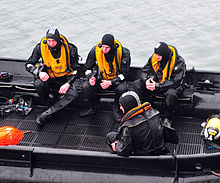
The Naval Service Diving Section (NSDS) (Irish: Rannóg Tumadóireachta na Seirbháse Cabhlaigh), formally part of NOC's shore operations section, is a specialist unit of the Irish Naval Service, a branch of the Defence Forces, the military of Ireland. The Naval Service Diving Section specialises in underwater diving tasks for the Naval Service, and since its formation in 1964 has become Ireland's most advanced diving team, aiding other state agencies in various specialist roles.[33]
Various mission roles of the NSDS include search and recovery, underwater survey, explosive ordnance disposal (EOD) underwater engineering and military diving training. They have conducted combat diving training for Army Ranger Wing members after selecting combat diving as a speciality.[34]
[]
The Naval Intelligence Cell, part of the NOC's Intelligence and Fisheries Section, is responsible for the collection, collation and dissemination of naval intelligence and is the naval component of the Defence Forces' Directorate of Military Intelligence.[35]
Fishery Monitoring Centre[]
The Fishery Monitoring Centre, part of the NOC's Intelligence and Fisheries Section, oversees the identification, monitoring and surveillance of fisheries vessels in Irish waters as part of the Vessel Monitoring System. The Fishery Monitoring Centre coordinates with fisheries agencies in other countries.[36]
Roles and capabilities[]
The Naval Service's military roles and the functions it carries out are more those of a coast guard rather than that of a conventional navy.[37] Lacking both anti-submarine and anti-aircraft capabilities, and without standoff weapons such as surface-to-surface missiles, the Naval Service's ability to control Ireland's territorial waters and provide close naval support is extremely limited.[original research?] Sea lift is also limited and ad hoc.[citation needed] The Naval Service's non-military capabilities in aid to the civil power and other government departments is fishery protection, search and rescue, drugs interdiction and dive support.
Irish territorial waters and EEZ[]
Since the 1960s Ireland has seen its jurisdiction over the North Atlantic extend from 3 nautical miles (5.6 km; 3.5 mi) (pre-1967) to 12 nautical miles (22 km; 14 mi) (pre-1990s). This was increased to 200 nautical miles (370 km; 230 mi) again in 1994 when the introduction of the exclusive economic zone (EEZ) gave approval to the 1982 United Nations Convention on the Law of the Sea (UNCLOS). This convention grants the state sovereign rights over the seabed, its subsoil and the water adjacent to the seabed within the 200 nautical mile limit.
Negotiations are taking place that could see the influence of coastal states extended beyond the 200 nautical miles of EEZs.[citation needed] Part VI of UNCLOS concerns a coastal state's continental shelf out to 350 nautical miles (650 km; 400 mi) from the coastline. In 2007, Ireland became the first country to gain approval for the extension of its continental shelf, to the west of the island, and now has responsibility for an area of some 141,000 square nautical miles (480,000 km2; 187,000 sq mi) – an increase of 100 per cent.[citation needed]
Among the tasks mandated to the NSDS include the following;[33]
- Search and recovery
- Underwater survey
- Explosive ordnance disposal
- Underwater engineering
- Military diving training
[]
In July 2017 the Irish government agreed to allowing the Naval Service to join other EU member state navies in Operation Sophia (the EU operation focused on refugee smuggling in the Mediterranean).[38] Since 2015 the Irish Navy has had bilateral agreement called with the Italian Navy in regards to Mediterranean search and rescue operations.[39] In order for Ireland to join the mission it required the passing of the so-called "triple lock system". This requires cabinet, Dáil and UN approval.[40] In its previous stance the Irish Navy was limited in its remit and sourcing of intelligence due to its lack of participation in EU Navfor Med. There was also a lack of force protection in the event of an attack on Irish vessels but this changed with the go-ahead for EU participation.[39]
Assets[]
Until 2014, all Naval Service vessels were named with traditional Irish female names, taken from history and Celtic mythology. However, the four newest in the fleet, LÉ Samuel Beckett (commissioned 17 May 2014), LÉ James Joyce (commissioned in September 2015), LÉ William Butler Yeats (commissioned 17 October 2016) and LÉ George Bernard Shaw (commissioned 30 April 2019) take their names from Irish literary figures. The ship prefix LÉ stands for Long Éireannach, "Irish ship" in the Irish language.
Current fleet[]
Sorted by tonnage.
| Class | Picture | Type | Ships | Commissioned | Displacement | Note |
|---|---|---|---|---|---|---|
| Patrol vessels | ||||||
| Samuel Beckett class | 
|
Offshore patrol vessel | LÉ Samuel Beckett (P61) LÉ James Joyce (P62) LÉ William Butler Yeats (P63) LÉ George Bernard Shaw (P64) |
2014 2015 2016 2019[41] |
2,256 tonnes | |
| Eithne class | 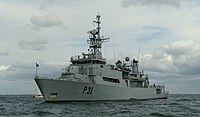
|
Offshore patrol vessel | LÉ Eithne (P31) | 1984 | 1,960 tonnes | Current fleet flagship.[42] LÉ Eithne was placed in "operational reserve" from July 2019 until March 2020, at which time it formed part of Ireland's response to the coronavirus pandemic.[43][44] |
| Róisín class | 
|
Offshore patrol vessel | LÉ Róisín (P51) LÉ Niamh (P52) |
1999 2001 |
1,500 tonnes | LÉ Róisín withdrawn from operation for "midlife refit" in 2019.[45] |
| Peacock class | 
|
Corvette | LÉ Orla (P41) LÉ Ciara (P42) |
1988 1988 |
712 tonnes | LÉ Orla placed in "operational reserve" in 2019.[43] |
Other assets[]
The Naval Service also operates smaller training vessels and rigid-hulled inflatable boats.
Air assets to support naval patrols are provided by the Air Corps with their two CASA CN-235 maritime patrol aircraft and AW139 helicopters operated from Casement Aerodrome, Baldonnel, County Dublin.
In July 2015, the Irish Naval Service began using an Irish-based satellite communications system for its fleet, with new systems and equipment installed on all vessels. The Irish National Space Centre (NSC) at Elfordstown, Midleton, County Cork, and County Wicklow based company Voyager IP provided the contract.[46]
Acquisitions and future[]
In October 2010 contracts were signed for two new "offshore patrol vessels" (OPVs). The contract provided an option for a third vessel – which was later taken-up. A fourth vessel in the same class was ordered in June 2016.[47] Constructed by Babcock Marine in the UK to VARD Marine's PV90 design, the first ship, Samuel Beckett, was delivered in May 2014. The second ship, James Joyce, was delivered in 2015.[48] The third, William Butler Yeats, was floated out in March 2016 and delivered later that summer.[25] A fourth, named George Bernard Shaw, was delivered in late 2018, and commissioned in April 2019.[49] These Samuel Beckett-class OPVs replace the older vessel classes, such as the Emer class.
A number of these purchases were informed by a Whitepaper on Defence which expected acquisition of three new naval vessels over 10 years from 2015 to 2025,[50] As well as the acquired and ordered OPVs, the whitepaper covered a multi-role vessel (MRV) – which would be potentially enabled for helicopter operations and have a freight carrying capacity – to replace the flagship LÉ Eithne.[50] In 2017, a delegation of DoD officials and members of the Defence Forces visited New Zealand to inspect the Royal New Zealand Navy's multi-role vessel HMNZS Canterbury; it was suggested that a vessel of this type, capable of accommodating and deploying a full infantry company either by landing craft or helicopter, and with a fully equipped hospital, was what the Defence Forces were looking for, for the type of military and humanitarian missions undertaken by Ireland.[51] Plans expect that LÉ Ciara and LÉ Orla be replaced with similar vessels[50] but with counter-mine and counter-IED capabilities.[52]
Decommissioned[]

The following vessels have served in the service's fleet:[53]
- LÉ Macha (01) (1946–1970)
- LÉ Maev (02) (1946–1972)
- LÉ Cliona (03) (1947–1970)
- LÉ Grainne (CM10) (1971–1987)
- LÉ Banba (CM11) (1971–1984)
- LÉ Fola (CM12) (1971–1987)
- LÉ Deirdre (P20) (1972–2001)
- LÉ Setanta (A15) (1976–1984)
- LÉ Ferdia (A16) (1977–1978)
- LÉ Emer (P21) (1978–2013)
- LÉ Aoife (P22) (1979–2015)
- LÉ Aisling (P23) (1980–2016)
Weapons[]
| Name | Origin | Type | Caliber | Photo | Notes | |
|---|---|---|---|---|---|---|
| Assault rifle | ||||||
| Steyr AUG | Assault rifle | 5.56×45mm | Standard service rifle since 1989 | |||
| Pistol | ||||||
| Heckler & Koch USP | Semi-automatic pistol | 9×19mm | 
|
Standard service pistol[54] | ||
| Battle rifle | ||||||
| FN FAL | Battle rifle | 7.62×51mm | Only used for line throwing | |||
| Machine gun | ||||||
| FN MAG | Machine gun | 7.62×51mm | 
|
Fitted onboard Naval Service ships for close range weapons support and anti-air point defence. Can also be mounted on RHIBs | ||
| M2 Browning .5 heavy machine gun (HMG) | Machine gun | 12.7×99mm (.50) | 
|
Fitted onboard Naval Service ships for close range weapons support and anti-air point defence | ||
| Autocannon | ||||||
| Rheinmetall Rh 202 | Autocannon | 20×139mm | 
|
Fitted onboard all Naval Service ships for close range weapons support and anti-air point defence | ||
| Bofors 57 mm L/70 | Autocannon | 57×438mm | 
|
Main weapon mounted onboard flagship LÉ Eithne | ||
| Naval gun | ||||||
| OTO Melara 76 mm | Autocannon | 76×900mmR | 
|
Main weapon mounted onboard LÉ Orla, LÉ Ciara, LÉ Róisín, LÉ Niamh, LÉ Samuel Beckett, LÉ James Joyce, and LÉ William Butler Yeats | ||
Personnel and ranks[]
As of May 2016, there are 1,094 personnel of all ranks in the Naval Service,[2] plus approximately 150 in the Naval Service Reserve.[55] The Naval Service is headed by a general officer commanding (GOC) known as the "flag officer commanding the naval service" (FOCNS), who holds the rank of commodore.[56] Non-military training takes place alongside Mercantile Marine personnel at the National Maritime College of Ireland in Ringaskiddy, near to the Haulbowline base.[57]
[]
| Equivalent NATO code | OF-8 | OF-7 | OF-6 | OF-5 | OF-4 | OF-3 | OF-2 | OF-1 | OF(D) | |
|---|---|---|---|---|---|---|---|---|---|---|
Ireland |

|

|

|

|

|

|

|

|

|

|
| Irish | Leas-Aimiréal | Seachaimiréal | Ceannasóir | Captaen | Ceannasaí | Leifteanant-Cheannasaí | Leifteanant | Fo-Leifteanant | Meirgire | Dalta |
| English | Vice admiral | Rear admiral | Commodore | Captain | Commander | Lieutenant commander | Lieutenant | Sub lieutenant | Ensign | Officer cadet |
[]
| Equivalent NATO code | OR-9 | |||
|---|---|---|---|---|
Ireland |
 Executive |
 Administrative |
 Engineering |
 Communications |
| Irish | Oifigeach Barántais | |||
| English | Warrant officer | |||
[]
| Equivalent NATO code | OR-8 | OR-7 | OR-6 | OR-5 | OR-4 | OR-3 | OR-2 | OR-1 |
|---|---|---|---|---|---|---|---|---|
Ireland |

|

|

|

|

|

|

|
No insignia |
| Irish | Ard-Mhion-Oifigeach Sinsearach | Ard-Mhion-Oifigeach | Mion-Oifigeach Sinsearach | Mion-Oifigeach | Mairnéalach Ceannais | Mairnéalach Inniúil | Mairnéalach | Earcach |
| English | Senior chief petty officer | Chief petty officer | Senior petty officer | Petty officer | Leading seaman | Able seaman | Ordinary seaman | Recruit |
See also[]
Footnotes[]
- ^ "The Defence Forces". Irish Defence Forces. Archived from the original on 14 April 2010. Retrieved 24 April 2014.
- ^ Jump up to: a b "Defence Forces Strength (Dáil Éireann Debate – Tuesday, 21 June 2016 – Vol. 914 No. 1)". Dáil Éireann Hansard. 21 June 2016. Retrieved 26 July 2016.
- ^ "Written Answers: Department of Defence". Dáil Éireann Hansard. 10 November 2020. Retrieved 1 June 2021.
- ^ "Info Centre > General staff > Brigade commanders > FOC Naval Service". Defence Forces Ireland. Retrieved 25 January 2018.
- ^ The Irish Defence Forces are made up of the Permanent Defence Forces (PDF) – the standing branches – and the Reserve Defence Forces (RDF). The Naval Service is part of the PDF.
- ^ "History of the Naval Service". Official Defence Forces website. Retrieved 7 May 2014.
- ^ "Roles of the Naval Service – Fisheries Monitoring Centre". Official Defence Forces website. Retrieved 7 May 2014.
- ^ "Military.ie – Naval Service – History". Official Defence Forces website. Retrieved 28 July 2014.
(1999–2001) "Fishery Protection played an important role in the Service's day-to-day operations" (2002–present) ".. addition to the Naval Service's increasing fishery protection output ..
- ^ "Press Release – Naming and Commissioning Ceremonies for new Naval Service Vessel LÉ Samuel Beckett". MerrionStreet.ie Irish Government News Service. 17 May 2014. Retrieved 28 July 2014.
The [newsest fleet addition] will be used mainly for fishery protection patrols
- ^ "Submission on Defence Green Paper: Towards an Efficient and Effective Fisheries Protection Partnership". The Sea-Fisheries Protection Authority. 2013. Archived from the original on 14 March 2016. Retrieved 16 June 2016.
- ^ "The Naval Service". inshore-Ireland.com. 19 February 2008. Archived from the original on 14 March 2016. Retrieved 16 June 2016.
- ^ "Casting the Net" (PDF). Signal. No. Spring 2004. Retrieved 16 June 2016.
- ^ "[Oireachtas] Defence Forces operations [39967/12]. (20 Sep 2012)". HRB National Drugs Library. 20 September 2012. Archived from the original on 15 March 2016. Retrieved 16 June 2016.
- ^ Jump up to: a b "Roles of the Naval Service". Official Defence Forces website. Retrieved 7 May 2014.
- ^ Bourke, Dr Edward. "Early Irish Free State Naval Activity". lugnad.ie. Retrieved 6 October 2015.
- ^ Articles of Agreement between Great Britain and Ireland, 6 December 1921 (Irish Free State established pursuant thereto on 6 December 1922)
- ^ "History of the Maritime Institute of Ireland – Page 2". Archived from the original on 28 May 2009. Retrieved 1 October 2009.
- ^ "Irish torpedo boats in the 1940s". Coast Monkey Media. 29 August 2017. Retrieved 6 December 2017.
- ^ "Irish Naval Service – The Birth". National Maritime Museum of Ireland. Retrieved 6 December 2017.
- ^ Donal MacCarron (2012). The Irish Defence Forces since 1922. Bloomsbury. p. 19. ISBN 9781780963938.
[The] Marine Service in 1939 bought six Vosper motor torpedo boats
- ^ "Price of fighting in the second World War". irishtimes.com. Irish Times. 6 November 2010. Retrieved 12 September 2020.
The [motor torpedo boat] crew made two trips across the English Channel, rescuing French and British soldiers
- ^ MacCarron, Donal (2004). The Irish Defence Forces since 1922. Osprey Publishing. p. 36. ISBN 9781841767420.
- ^ RTÉ documentary: "The Navy"
- ^ "Ships – history" Archived 26 November 2010 at the Wayback Machine, Irish Defence Forces website
- ^ Jump up to: a b "Government to purchase third new Naval Service ship". The Irish Times. 9 June 2014.
- ^ "LÉ William Butler Yeats formally enters service". Raidió Teilifís Éireann. 17 October 2016.
- ^ Sean O'Riordan (24 May 2012). "Navy ships to carry deep sea robot subs". Irish Examiner. Retrieved 24 April 2014.
- ^ "Taoiseach sends off LE Eithne crew leaving for Mediterranean". The Irish Times. Retrieved 5 June 2015.
- ^ "Minister for Defence, Simon Coveney, T.D. welcomes the return of the L.É. Eithne and the arrival of L.É. James Joyce to Cork". defence.ie. Department of Defence. 17 July 2015. Retrieved 28 October 2015.
- ^ "Naval vessel L.É. Niamh departs Cork to assist in the Humanitarian Crisis in the Mediterranean". defence.ie. Department of Defence. 10 July 2015. Retrieved 28 October 2015.
- ^ "Naval vessel L.É. Samuel Beckett departs Cork to assist in the Humanitarian Crisis in the Mediterranean". defence.ie. Department of Defence. 24 September 2015. Retrieved 28 October 2015.
- ^ "Irish Naval Service Course Details". National Maritime College of Ireland. Retrieved 2 January 2017.
- ^ Jump up to: a b "Naval Service Specialists – Diving Section". Irish Naval Service. 2009. Archived from the original on 9 September 2009. Retrieved 1 October 2009.
- ^ "Special Operations' Irish Army Rangers Combat Diving Page". Archived from the original on 28 December 2008. Retrieved 1 October 2009.
- ^ "Naval Operations Command". Irish Defence Forces. Retrieved 2 January 2017.
- ^ "Fisheries Monitoring Centre". Irish Defence Forces. Retrieved 1 January 2017.
- ^ MacCarron (2004), p.37
- ^ "Concern as Cabinet approves Irish Navy role in EU military operation". The Irish Times. 11 July 2017. Retrieved 2 November 2018.
- ^ Jump up to: a b "Irish Navy to join EU migrant search-and-rescue operation". The Irish Times. 10 July 2017. Retrieved 2 November 2018.
- ^ "Press Release – Minister Kehoe Secures Dáil Approval For Deployment of Defence Forces To Eu Naval Mission, Operation Sophia". defence.ie. Department of Defence. 13 July 2017. Retrieved 2 November 2018.
- ^ "Ireland's fourth offshore patrol vessel, the LÉ George Bernard Shaw, has been officially commissioned". thejournal.ie. The Journal. 30 April 2019. Retrieved 30 April 2019.
- ^ "Naval Service > Fleet > Helicopter Patrol Vessel > LÉ Eithne P31". Military.ie. Retrieved 28 March 2017.
- ^ Jump up to: a b "Taoiseach acknowledges Naval Service is short staffed". rte.ie. RTÉ News. 8 July 2019. Retrieved 7 December 2019.
- ^ O'Riordan, Sean (18 March 2020). "Navy returning LÉ Eithne to service as Cork Covid-19 testing centre". Irish Examiner. Retrieved 20 March 2020.
- ^ "Decision on Mediterranean rescue missions met with disappointment". irishtimes.com. Irish Times. 9 July 2019. Retrieved 7 December 2019.
- ^ O’Riordan, Sean (10 July 2015). "Irish firms to man Navy system". Irish Examiner. Retrieved 10 July 2015.
- ^ Brady, Tom (16 June 2016). "State to buy third naval vessel in €200m deal". Irish Independent. Retrieved 16 June 2016.
- ^ "Irish OPV build makes progress". ihs.com. Retrieved 8 October 2013.
- ^ "Ireland's fourth offshore patrol vessel, the LÉ George Bernard Shaw, has been officially commissioned". The Journal. 30 April 2019. Retrieved 30 April 2019.
- ^ Jump up to: a b c "'Fund Defence to prevent terror attacks' says Simon Coveney". Irish Examiner. 27 August 2015.
- ^ O'Riordan, Sean (12 October 2017). "Navy considers €200m multi-role ship". Irish Examiner. Retrieved 1 November 2017.
- ^ White Paper on Defence 2015 (Report). Department of Defence (Ireland). August 2015. p. 68. Archived from the original on 1 February 2017. Retrieved 29 August 2015.
- ^ "History; Naval Service". Irish Defence Forces. Retrieved 24 April 2014.
- ^ Don Lavery – 2 September 2006 (2 September 2006). "Defence Forces to turn 'tomb raiders'". The Irish Independent. Retrieved 29 April 2013.
- ^ "Written Replies Nos. 437 to 450 – Defence Forces Reserve". Office of the Houses of the Oireachtas (Hansard). 13 January 2016.
- ^ "Naval Service > Organisation". Defence Forces Ireland. Retrieved 12 July 2015.
- ^ "History of Nautical Training in Ireland". National Maritime College of Ireland. Retrieved 24 April 2014.
External links[]
| Wikimedia Commons has media related to Irish Naval Service. |
- Ireland military ship templates
- Irish Naval Service
- Military of the Republic of Ireland
